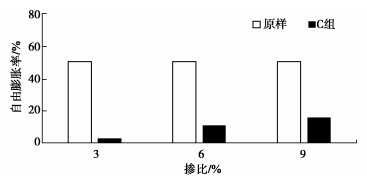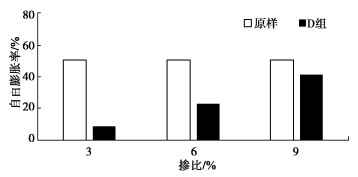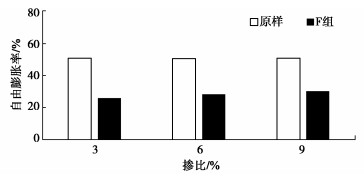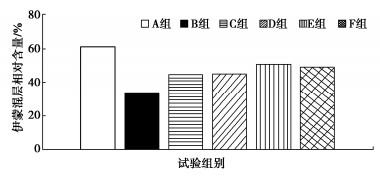Experimental study on engineering characteristics of composite improvement of expansive soil by using microbial technology
-
摘要: 膨胀土是岩土工程界的公认难题之一,基于微生物技术,结合石灰、水泥、粉煤灰等改良材料,系统开展了复合改良膨胀土的工程特性试验研究。结果表明:①微生物复合改良膨胀土成功的将弱膨胀土变为无膨胀土,自由膨胀率最低降低至8%,降幅达84.31%,工程效果良好。②经复合处理试样中的蒙脱石相对含量降低、伊利石相对含量上升是抑制胀缩特性的一个重要原因。③膨胀土中单掺菌液20%情况下,摩擦角同比可增加23%。④菌液、粉煤灰、石灰复合改良膨胀土情况下,石灰掺比1%粉煤灰2%的低掺比组合对提高强度更为有利。Abstract: The expansive soil is one of the recognized challenges in the field of geotechnical engineering. Based on the microbial technology, combined with the improved materials such as lime, cement and fly ash, the experimental researches on the engineering characteristics of composite improved expansive soil are conducted. The results show that: (1) The weak expansive soil is successfully changed into the non-expansive one by the microbial composite improvement of expansive soil, and the free expansion rate is reduced to 8% at the lowest, with a decrease of 84.31%. The engineering effect is good. (2) The decrease of the relative content of montmorillonite and the increase of the relative content of illite in the composite treated samples are the important reason for inhibiting the expansion and contraction characteristics. (3) When the bacterial solution of 20% is added to the expansive soil, the friction angle can increase by 23% compared to that at the same time last year. (4) In the case of composite improvement of expansive soil with bacterial solution, fly ash and lime, a low ratio combination of lime of 1% and fly ash of 2% is more advantageous for improving the strength.
-
Keywords:
- expansive soil /
- microorganism /
- compsite improvement /
- engineering characteristic
-
-
表 1 复合改良处理对膨胀土固化强度影响试验设计
Table 1 Experimental design for the effect of composite improvement treatment on the solidification strength of expansive soil
试验
组别含水率或掺比 试验编号 A 水+膨胀土、含水率10% A10 水+膨胀土、含水率15% A15 水+膨胀土、含水率20% A20 水+膨胀土、含水率25% A25 B 菌液+膨胀土、含水率10% B10 菌液+膨胀土、含水率15% B15 菌液+膨胀土、含水率20% B20 菌液+膨胀土、含水率25% B25 C 菌液20%、粉煤灰掺比3% C3 菌液20%、粉煤灰掺比6% C6 菌液20%、粉煤灰掺比9% C9 D 菌液20%、石灰掺比3% D3 菌液20%、石灰掺比6% D6 菌液20%、石灰掺比9% D9 E 菌液20%、石灰1%、粉煤灰2% E3 菌液20%、石灰2%、粉煤灰4% E6 菌液20%、石灰3%、粉煤灰6% E9 F 菌液20%、粉煤灰1%、石灰1%、水泥1% F3 菌液20%、粉煤灰2%、石灰2%、水泥2% F6 表 2 水+膨胀土不同含水率抗剪强度指标
Table 2 Shear strength indicators of water + expansive soil with different moisture contents
组别 c/kPa φ/(°) A10 12.96 29.9 A15 46.87 29.5 A20 55.04 23.4 A25 59.34 21.0 表 3 菌液+膨胀土不同含水率抗剪强度指标
Table 3 Shear strength indicators of bacterial solution + expansive soil with different moisture contents
组别 c/kPa φ/(°) B10 8.44 31.2 B15 5.33 32.4 B20 39.37 28.9 B25 47.87 17.5 表 4 菌液、粉煤灰+膨胀土抗剪强度指标
Table 4 Shear strength indicators of bacterial solution, fly ash + expansive soil
组别 c/kPa φ/(°) C3 35.44 24.2 C6 12.96 29.7 C9 23.2 25.3 表 5 菌液、石灰+膨胀土抗剪强度指标
Table 5 Shear strength indicators of bacterial solution, lime + expansive soil
组别 c/kPa φ/(°) D3 6.02 29.4 D6 26.66 32.5 D9 34.53 26.1 表 6 菌液、粉煤灰、石灰+膨胀土抗剪强度指标
Table 6 Shear strength indicators of bacterial solution, fly ash + expansive soil
组别 c/kPa φ/(°) E3 18.93 34.9 E6 19.38 27.2 E9 21.49 21.49 表 7 菌液、粉煤灰、石灰、水泥+膨胀土抗剪强度指标
Table 7 Shear strength indicators of bacterial solution, fly ash + expansive soil
组别 c/kPa φ/(°) F3 20.81 24.3 F6 28.97 30.6 F9 31.93 26.9 -
[1] 廖世文. 膨胀土与铁路工程[M]. 北京: 中国铁道出版社, 1984. LIAO Shiwen. Expansive Soil and Railway Engineering[M]. Beijing: China Railway Publishing House, 1984. (in Chinese)
[2] 刘清秉, 项伟, 吴云刚. 膨胀土工程特性及改性理论研究[M]. 武汉: 中国地质大学出版社, 2015. LIU Qingbing, XIANG Wei, WU Yungang. Study on Engineering Characteristics and Modification Theory of Expansive Soil[M]. Wuhan: China University of Geosciences Press, 2015. (in Chinese)
[3] 谢长征. 膨胀土路基填料石灰改良机理研究[D]. 武汉: 湖北工业大学, 2017. XIE Changzheng. Study on Lime Improvement Mechanism of Expansive Soil Subgrade Filler[D]. Wuhan: Hubei University of Technology, 2017. (in Chinese)
[4] CHEW S H, KAMRUZZAMAN A H M, LEE F H. Physicochemical and engineering behavior of cement treated clays[J]. J Geotech Geoenviron, 2004, 130(7): 696-706. doi: 10.1061/(ASCE)1090-0241(2004)130:7(696)
[5] ZHAO H H, GE L, PETRY T M, et al. Effects of chemical stabilizers on an expansive clay[J]. KSCE Journal of Civil Engineering, 2014, 18(4): 1009-1017. doi: 10.1007/s12205-013-1014-5
[6] 阎葆瑞, 张锡根. 微生物成矿学[M]. 北京: 科学出版社, 2000. YAN Baorui, ZHANG Xigen. Microbial Metallogeny[M]. Beijing: Science Press, 2000. (in Chinese)
[7] MARTINEZ B C, DEJONG J T, GINN T R, et al. Experimental optimization of microbial-induced carbonate precipitation for soil improvement[J]. Journal of Geotechnical and Geoenvironmental Engineering(ASCE), 2013, 139(4): 587-598. doi: 10.1061/(ASCE)GT.1943-5606.0000787
[8] MUJAH D, SHAHIN M A, CHENG L. State-of-the-art review of biocementation by microbially induced calcite precipitation (micp) for soil stabilization[J]. Geomicrobiology, 2017, 34(6): 524-537. doi: 10.1080/01490451.2016.1225866
[9] XIAO J Z, WEI Y Q, CAI H, et al. Microbial-induced carbonate precipitation for strengthening soft clay[J]. Advances in Materials Science and Engineering, 2020: 8140724.
[10] WEI R, XIAO J Z, WU S F, et al. Effectiveness of microbially induced calcite precipitation for treating expansive soils[J]. Advances in Civil Engineering Materials, 2021, 10(1): 350-361.
-
期刊类型引用(2)
1. 吴雄华,邹振杰. 生物炭-水泥固化膨胀土物理力学特性及其影响机理研究. 公路. 2025(04): 409-416 .  百度学术
百度学术
2. 胡波,李浩洋,童军,王卫,查恒,夏锐. 磷石膏改性膨胀土工程特性演变规律试验研究. 人民长江. 2025(05): 156-161 .  百度学术
百度学术
其他类型引用(4)




 下载:
下载:




